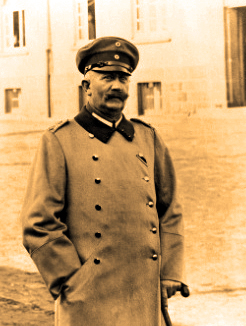<bgsound src="/book/holzminden.wav" data-mce-src="/book/holzminden.wav"></bgsound>
|

Hauptmann Karl Niemeyer
Kommandant, Kaserne Holzminden
|
When captured Allied prisoners began to spill into Germany, the steady flow took even the Germans by surprise. Caught on the back foot, several potential establishments dotted across the country were identified and quickly converted into POW camps to accommodate the prisoners.
Kaserne Holzminden in Lower Saxony opened its gates in September 1917, having previously served as a cavalry training facility. Barbed wire was hastily installed, locks were applied to doors and walls panels and doors were nailed shut. When the Germans believed the camp to be escape-proof, the first wave of POWs were admitted. The unfinished bath-house, which kennelled the tracking bloodhounds until a facility could be built for them, meant that scores of POWs were forced to bathe in the horse trough -- even through the icy European winter.
The facility was commanded by the cocky and confident Hauptmann Karl Niemeyer, a relic from the Prussian wars who had spent 17 years living in the USA with his twin brother, Heinrich, before the war and spoke a hybrid English which often had the POWs in hysterics. Niemeyer prided himself on running the country's most inescapable POW camp and didn't waste an opportunity to strut around like a peacock, boasting about it.
Niemeyer had earned himself an appalling reputation for mistreatment amongst not only the POWs in his care, but his own staff and guards. This was to be his downfall -- the Germans serving the camp were starving and underpaid, leaving them susceptible to food and monetary bribes from the British and Allied prisoners ...
Read about how the POWS achieved the infamous Holzminden mass tunnel escape: www.facesofholzminden.com/the-tunnel |
